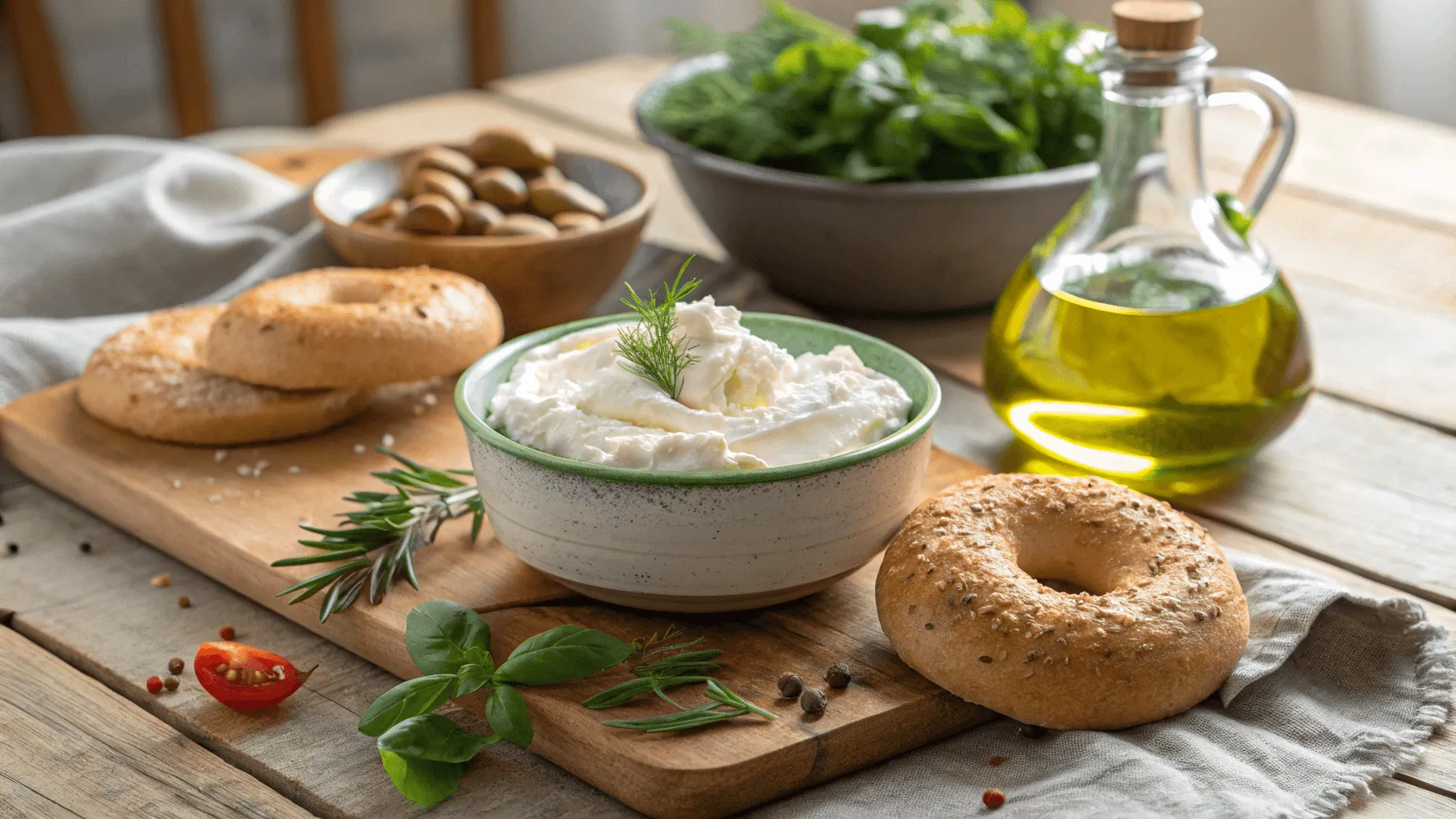Introduction: Why Greek cream cheese is trending in kitchens worldwide
If you’ve ever wished your cream cheese felt a little protein-packed and a little extra tangy, Greek cream cheese might just be your new fridge superstar. It’s like regular cream cheese went on a wellness retreat with Greek yogurt and came back lighter, brighter, and ready to spread on everything. From bagels to baked casseroles, this creamy dream delivers that familiar richness with a fresh, slightly tangy twist that makes recipes feel modern and a little more wholesome. And yes, it’s having a moment because people want food that tastes indulgent but still fits everyday health goals. Win-win, right? 🥯✨
Here’s the short story: Greek cream cheese is the kitchen equivalent of swapping your heavy winter coat for a cozy, breathable jacket. Still warm, still comfy, just a bit more flexible. It sits beautifully in both savory and sweet recipes, keeps you full longer thanks to more protein, and plays nicely with herbs, spices, fruits, and even chocolate. If you’ve been curious or you’re just tired of choosing between “rich” and “light” this guide will show you how Greek cream cheese gives you both.
“Think of Greek cream cheese as cream cheese with a passport classic roots, global flavor, and a balanced nutrition profile.”
You’ll learn what it is, how it’s different from regular cream cheese, what it tastes like, and where labneh fits into the conversation. Plus, we’ll tackle common problems and simple fixes so your dips, spreads, sauces, and desserts come out silky and delicious every time.
Table of Contents
What is Greek cream cheese?
Greek cream cheese is a hybrid dairy product that blends the tang and protein of Greek yogurt with the smooth richness of cream cheese. Imagine a spread that’s creamy enough to frost a cake but light enough to dollop on a roasted veggie bowl. That’s the vibe. It’s typically made by combining cultured milk and cream and then straining it to concentrate protein and reduce whey, much like Greek yogurt. The result is a thicker, slightly tangier cream cheese that still spreads beautifully.
You’ll spot it by its texture first: thick, velvety, and spoon-hugging. If regular cream cheese is a satin sheet, Greek cream cheese is a plush blanket soft, cozy, and a touch more structured. It’s designed for people who love the taste of cream cheese but want something that feels better balanced and a bit more nourishing for everyday use.
“If regular cream cheese is your comfort classic, Greek cream cheese is the remix same groove, brighter notes, and a little more lift.”
Beyond the basics, what makes Greek cream cheese special is its versatility. Use it as a spread on bagels, swirl it into soups for instant body, whip it into frosting for a lighter finish, or fold it into dips that taste luxurious but leave you feeling energized, not weighed down. It’s a secret sauce kind of ingredient the one that quietly upgrades your kitchen without demanding a full recipe overhaul.
Origins and history of Greek cream cheese
While traditional cream cheese has deep roots in American and European kitchens, Greek cream cheese is a newer innovation inspired by the popularity of Greek yogurt. Traditional Greek cheeses like Manouri also share a creamy texture and are sometimes used as substitutes for cream cheese in recipes. As Greek yogurt exploded in demand for its higher protein and satisfying texture, dairy makers adapted cream cheese to join that party: same iconic creaminess, boosted with the yogurt’s tang and nutrition profile. Think of it as the natural next step in the yogurt-to-table trend first smoothies, then breakfast bowls, and now spreads, sauces, and bakes.
How Greek cream cheese is made
Greek cream cheese is typically created by blending cultured dairy (often Greek yogurt or a similar strained yogurt) with cream and milk, then gently processing and straining to achieve a thick, smooth consistency. The culturing step adds tang and the straining step boosts protein concentration and reduces excess moisture. This balance is key: too much cream and it feels heavy; too much yogurt and it tastes overly sharp. The magic happens in the middle creamy, tangy, spreadable, and stable enough to hold up in cooking.
What is the difference between Greek cream cheese and regular cream cheese?
Let’s break it down in real-life terms, not label-speak. When you grab regular cream cheese, you expect rich, mild, and perfectly smooth. But what’s the difference between Greek cream cheese and cream cheese? Greek cream cheese keeps the creaminess, but adds a gentle tang and a denser, slightly more structured texture. It often contains more protein and may have a modest reduction in fat or calories depending on the brand. In the mouth, it feels like a cross between cream cheese and thick yogurt balanced, bright, and satisfying.
In recipes, the difference shows up as stability and flavor lift. Greek cream cheese blends easily into hot sauces without splitting, gives dips a “fresh” finish without tasting sour, and helps cheesecakes feel lighter while staying creamy. That subtle tang is what makes flavors pop herbs taste more vibrant, citrus tastes more sun-kissed, and even chocolate feels richer when there’s a tiny bit of contrast to play against.
Texture and consistency comparison
- Mouthfeel: Regular cream cheese is ultra-smooth and plush. Greek cream cheese is smooth too, but with a little more body less slick, more spoon-standing.
- Spreadability: Both spread well. Greek cream cheese can feel firmer right out of the fridge, but softens quickly and holds shape better in piping and layering.
- Stability: Greek cream cheese handles gentle heat and mixing well, making it great for warm dips, sauces, and baked fillings where you want structure.
Nutritional differences protein, fat, and calories
Greek cream cheese often leans toward a higher protein profile thanks to its yogurt base and straining process. Many versions offer a better protein-to-calorie ratio than traditional cream cheese. Depending on the brand, you might see slightly lower fat or fewer calories per serving, all while keeping the creamy texture that makes cream cheese so lovable. It’s not a diet food it’s a smart swap that fits everyday eating without sacrificing the joy of rich, creamy bites.
Flavor profile tangy vs. mild
Regular cream cheese is mild, buttery, and gently lactic. Greek cream cheese adds a clean, yogurt-like tang that brightens the flavor. Think of it like adding a squeeze of lemon to a sauce it wakes up the taste without overpowering it. If you love cream cheese that doesn’t feel flat, Greek cream cheese is your new go-to. And if tang scares you, don’t worry: it’s balanced, not sharp.
Cooking and baking performance
Greek cream cheese shines in cooking. In pasta sauces, it melts into a silky, slightly lighter alfredo that clings to noodles beautifully. For a bold appetizer idea, check out our smoked cream cheese guide it’s creamy, smoky, and unforgettable. In casseroles, it adds body without greasiness. In dips, it provides a firm-yet-creamy base that stands up to veggies and chips. For baking, it makes cheesecakes taste fresh and not overly heavy, especially when paired with citrus or berry flavors. Pro tip: when baking, let it come to room temperature for a smoother mix and fewer cracks.
What does Greek cream cheese taste like?
What does Greek cream cheese taste like? Picture classic cream cheese, then imagine it wearing a lemon-zest crown. Greek cream cheese tastes creamy first rich, velvety, and comforting followed by a gentle tang that feels clean and refreshing. It’s slightly savory, never sweet, but plays nicely with sweet ingredients because the tang adds contrast. That balance is the magic: it’s indulgent but awake.
On a plain bagel, you’ll notice the tang more. On a toasted everything bagel, the spices and seeds hug the tang and make the whole bite sing. In a dip with garlic and herbs, Greek cream cheese brings flavors forward, so you taste the dill and chives more clearly. With fruit, like strawberries or peaches, it adds a cheesecake-like vibe without the weight like a summer breeze in dessert form. 🍓
How taste changes when used in cooking vs. baking
Heat softens tang. In hot recipes think sauces, soups, warm dips the tang rounds out, leaving a creamy backbone with subtle brightness. In baking, the tang stays a bit more pronounced, which is perfect for cheesecakes, citrus bars, and frostings where you want flavor to pop. Cool applications (spreads, dips, parfaits) showcase the tang the most. If you’re on the fence, blend it 50/50 with regular cream cheese for the first try, then adjust to taste.
Is labneh Greek cream cheese?
Short answer: No labneh isn’t Greek cream cheese, but they are cousins in the dairy family. Labneh is a Middle Eastern strained yogurt cheese: thick, tangy, and usually enjoyed as a spread or dip, often drizzled with olive oil and sprinkled with herbs or za’atar. Greek cream cheese takes cues from strained yogurt, but it’s formulated to behave like cream cheese in both taste and performance. That means it’s creamier, less sharp, and built to spread, whip, and bake in ways labneh typically isn’t optimized for.
Understanding labneh middle eastern yogurt cheese
Labneh starts as yogurt cow’s or goat’s milk strained until it’s thick and spreadable. It’s tangier than cream cheese, naturally probiotic, and traditionally served with savory accents: olive oil, herbs, cucumbers, and flatbreads. Think mezze platter. It’s glorious for dipping and topping, and you can roll it into balls (labneh kefir cheese style) and preserve in olive oil. Flavor-wise, it’s bright, bracing, and deliciously creamy but it’s not trying to be dessert-ready cream cheese.
Key differences between labneh and Greek cream cheese
- Tang: Labneh is sharper; Greek cream cheese is milder and more balanced.
- Fat: Labneh is typically lower in fat unless enriched; Greek cream cheese has a cream component for that signature plush texture.
- Use case: Labneh excels as a savory spread and dip; Greek cream cheese works across sweet and savory, including baking.
- Texture: Labneh can be slightly looser or more crumbly depending on straining; Greek cream cheese is engineered to be uniformly smooth and spreadable.
When to use labneh vs. Greek cream cheese
Use labneh when you want punchy, fresh tang mezze board, grain bowls, roasted veggies, shawarma wraps. Use Greek cream cheese when you want creaminess with gentle brightness bagels, cheesecakes, frostings, pasta sauces, stuffed chicken, creamy dips. If a recipe calls for cream cheese and you only have labneh, blend labneh with a bit of butter or regular cream cheese to mellow tang and increase silkiness. If a recipe calls for labneh and you only have Greek cream cheese, add lemon juice and a pinch of salt to sharpen the flavor and thin to your desired consistency.
“Labneh is the life of the mezze party; Greek cream cheese is the host that makes sure every dish tastes just right.”
Health benefits of Greek cream cheese

Greek cream cheese isn’t just a tasty spread it’s also a little nutrition powerhouse. Many people choose it for its Greek cream cheese nutrition profile, which includes more protein and fewer calories than traditional cream cheese. If you’ve ever felt guilty about slathering cream cheese on your bagel, this version might ease your mind. Because it’s made with Greek yogurt, it usually has more protein and less fat than traditional cream cheese. That means you’re getting a creamy bite that actually helps keep you full longer.
High protein for muscle and energy
Protein is like the building block of your body it repairs muscles, fuels energy, and keeps hunger at bay. Greek cream cheese often has double the protein of regular cream cheese, which makes it a smart choice for breakfast or snacks. Imagine spreading it on toast with smoked salmon you’re not just eating something delicious, you’re also giving your body a steady stream of energy to power through the morning.
Lower fat options for weight management
Many brands of Greek cream cheese are lower in fat compared to the classic block. That doesn’t mean it tastes “diet-y.” Instead, it feels lighter and fresher, which is perfect if you’re trying to cut back on heavy dairy without giving up creaminess. It’s like swapping whole milk for 2% you still get the flavor, just with a little less heaviness.
Probiotics and digestive health
Because Greek cream cheese is made with cultured yogurt, it often contains probiotics the friendly bacteria that support gut health. While the levels vary by brand, it’s a nice bonus. Think of it as a two-for-one deal: creamy indulgence plus a little digestive support.
“Greek cream cheese is proof that comfort food and smart choices can live on the same plate.”
Common problems with Greek cream cheese (and solutions)
Like any ingredient, Greek cream cheese isn’t perfect. Some people try it once and think, “Hmm, this is different.” But don’t give up most issues have easy fixes.
Problem: Too tangy for some tastes → Solution: Blend with regular cream cheese
If you’re used to the mildness of regular cream cheese, the tang of Greek cream cheese might surprise you. So, can you use Greek cream cheese instead of cream cheese? Absolutely just mix them together for a balanced flavor. A 50/50 blend gives you the best of both worlds creamy and mild, with just a hint of brightness.
Problem: Hard to find in stores → Solution: DIY Greek cream cheese at home
Not every grocery store carries Greek cream cheese, especially smaller ones. But don’t worry you can make your own with just two ingredients: Greek yogurt and cream. More on that in a moment.
Problem: Texture too thick → Solution: Whip with milk or cream
Sometimes Greek cream cheese feels a little dense, especially straight from the fridge. If you prefer something lighter, our whipped cream cheese recipe is fluffy, airy, and perfect for spreading. To fix this, whip it with a splash of milk or cream until it’s fluffy. This trick works wonders for frostings and dips.
Problem: Doesn’t melt smoothly → Solution: Combine with butter or sour cream
Because of its higher protein content, Greek cream cheese doesn’t always melt as seamlessly as the regular kind. If you’re making a sauce, stir in a little butter or sour cream to smooth things out.
How to make Greek cream cheese at home

Here’s the fun part you don’t have to rely on store-bought versions. Making Greek cream cheese at home is surprisingly easy, and you only need a couple of ingredients.
Ingredients you’ll need
- 2 cups full-fat Greek yogurt
- ½ cup heavy cream (for richness)
- Pinch of salt (optional)
Step-by-step process
- Line a strainer with cheesecloth or a clean kitchen towel and place it over a bowl.
- Mix yogurt and cream together in another bowl until smooth.
- Pour the mixture into the lined strainer.
- Cover and refrigerate for 12–24 hours, letting the liquid (whey) drain out.
- Transfer to a container and stir until creamy.
The longer you strain, the thicker it gets. After 12 hours, you’ll have a spreadable texture. After 24 hours, it’ll be dense and rich, almost like a whipped cream cheese.
Storage tips for freshness
Homemade Greek cream cheese keeps well in the fridge for about a week. Store it in an airtight container to prevent it from drying out. If you want to jazz it up, stir in fresh herbs, garlic, or even honey before storing.
“Homemade Greek cream cheese is like magic you start with yogurt and cream, and end up with something that feels gourmet.”
Best ways to use Greek cream cheese in recipes

Greek cream cheese is like the Swiss Army knife of the dairy world it does a little bit of everything. Whether you’re whipping up breakfast, lunch, dinner, or dessert, it slides right in and makes the dish creamier, tangier, and more satisfying.
Breakfast ideas: bagels, toasts, and smoothies
- Bagels & toast: The classic move is spreading it on a bagel, but don’t stop there. Try it on whole-grain toast with sliced strawberries and a drizzle of honey. It’s basically cheesecake for breakfast.
- Smoothies: Add a spoonful to your morning smoothie for extra creaminess and protein. It blends beautifully with bananas, berries, or even peanut butter.
- Egg dishes: Stir it into scrambled eggs or omelets for a velvety texture and a subtle tang that makes the flavors pop.
Lunch favorites: wraps, sandwiches, and dips
- Wraps & sandwiches: Swap mayo for Greek cream cheese in your turkey wrap or veggie sandwich. It adds creaminess without the heaviness.
- Dips: Mix it with herbs, garlic, and lemon juice for a quick veggie dip. Or go bold with buffalo sauce for a lighter spin on buffalo chicken dip.
- Soups: Stir a dollop into tomato soup or roasted red pepper soup for instant creaminess.
Dinner recipes: pasta sauces, casseroles, and stuffed chicken
- Pasta sauces: Greek cream cheese makes a silky Alfredo-style sauce that clings to noodles without feeling greasy.
- Casseroles:Add it to baked pasta or potato casseroles for a creamy binder that holds everything together. Or try our cream cheese cauliflower bake for a lighter, veggie-packed option.
- Stuffed chicken: Fill chicken breasts with Greek cream cheese, spinach, and sun-dried tomatoes. Bake until golden and juicy.
Desserts: cheesecakes, frostings, and parfaits
- Cheesecakes: Use it in place of regular cream cheese for a lighter, tangier cheesecake. Pair with lemon zest or berries for a refreshing twist.
- Frostings: Whip it with powdered sugar and vanilla for a creamy frosting that’s less sweet but still decadent.
- Parfaits: Layer it with granola and fruit for a dessert that doubles as breakfast. 🍓
“Greek cream cheese is the ingredient that makes everyday recipes feel like restaurant dishes without the restaurant bill.”
Greek cream cheese vs. other dairy products
Greek cream cheese vs. labneh
We touched on this earlier, but here’s the quick recap: labneh is tangier, more savory, and usually eaten with olive oil and herbs. Greek cream cheese is smoother, milder, and more versatile for both sweet and savory recipes.
Greek cream cheese vs. sour cream
Sour cream is looser, tangier, and often used as a topping. Greek cream cheese is thicker, richer, and works better as a base for dips or baked goods. If you’re out of sour cream, Greek cream cheese can step in just thin it with a splash of milk or lemon juice.
Greek cream cheese vs. yogurt
Greek yogurt is tangy and spoonable, but it doesn’t have the same richness. Greek cream cheese is like yogurt’s indulgent cousin still tangy, but with a creamy depth that makes it more satisfying in spreads and sauces.
Buying guide: where to find Greek cream cheese
Popular brands in the U.S. and Europe
Brands like Green Mountain Farms and Franklin Foods have popularized Greek cream cheese in the U.S. In Europe, you’ll often find it in specialty cheese sections or under private-label brands.
Specialty stores vs. supermarkets
Larger supermarkets usually carry it, but smaller stores may not. Specialty health food shops and gourmet markets are your best bet if you can’t find it in the dairy aisle.
Online shopping options
If all else fails, you can order Greek cream cheese online. Many brands ship directly, and some grocery delivery services stock it.
Storage and shelf life of Greek cream cheese
Refrigeration tips
Keep it tightly sealed in the fridge. Once opened, use it within 7–10 days for the best flavor and texture. Wondering, can you freeze Greek cream cheese? Yes, but freezing changes the texture, so it’s best for cooking rather than spreadingH3 Freezing Greek cream cheese: does it work?
Yes, but with a catch. Freezing changes the texture, making it crumbly. It’s fine for cooking (like casseroles or sauces), but not ideal for spreading on bagels.
Signs it has gone bad
If it smells sour (in a bad way), develops mold, or turns watery and grainy, it’s time to toss it.
FAQs about Greek cream cheese
Can you substitute Greek cream cheese for regular cream cheese?
Yes! In most recipes, you can swap them 1:1. Just remember Greek cream cheese has a tangier flavor, so it may slightly change the taste of desserts.
Is Greek cream cheese suitable for keto or low-carb diets?
Absolutely. It’s higher in protein and lower in carbs than many dairy products, making it a good fit for keto or low-carb lifestyles.
Is Greek cream cheese gluten-free?
Yes, naturally. Just check the label to make sure no additives contain gluten.
Conclusion: Why Greek cream cheese deserves a spot in your kitchen
Greek cream cheese is more than just a trendy dairy product it’s a game-changer. Whether you’re looking for a healthy cream cheese alternative, a high-protein spread, or a versatile ingredient for sweet and savory recipes, Greek cream cheese deserves a permanent spot in your kitchen. It gives you the creaminess you crave, the protein your body loves, and the versatility your recipes need. From bagels to cheesecakes, dips to pasta sauces, it’s the kind of ingredient that quietly makes everything better.
So next time you’re in the dairy aisle, grab a tub and experiment. Spread it, whip it, bake it, stir it Greek cream cheese is ready to play. And who knows? It might just become your new kitchen essential.
“Creamy, tangy, versatile Greek cream cheese is proof that sometimes, the remix is better than the original.” 🧀✨
